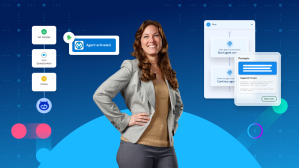Editor’s note: Einstein 1 Platform is now the Salesforce Platform. For the latest, go here.
A new analysis by 451 Research explores why some enterprises are hesitant to leverage traditional generative AI tools and how an approach known as retrieval augmented generation (RAG) is emerging to help overcome adoption challenges.
Why it matters: Most commercially available generative AI tools are based solely on large language models (LLMs), which can sometimes produce hallucinations, reflect the biases of the data they’re trained upon, or lack enough relevant domain knowledge to produce meaningful business insights. Organizations do their best to overcome such issues by “fine-tuning” their LLMs. But doing so can take significant time and money while consuming tremendous amounts of energy.
Diving deeper: RAG, which enables companies to use their structured and unstructured proprietary data to make generative AI more trusted and relevant, augments LLMs with an external vector database of data, like emails and call transcripts, thereby combining generative AI capabilities with domain-specific information that can reduce hallucinations and bias. Some of the other 451 Research takes include:
- Eighty-seven percent of enterprise leaders view RAG as a viable approach for providing LLMs with additional knowledge to prevent hallucinations, which occur when an AI doesn’t have enough training data to credibly answer a question but produces a result anyway — one that looks like fact.
- Vector databases can be updated more easily and frequently than static LLMs, meaning that a RAG approach has the added benefit of relying on more recent data than an LLM alone.
- RAG can help address security and privacy challenges with LLMs because proprietary data resides in a separate database.
Expert perspective:
- “RAG deployments can help quell enterprise concerns about trust, bias, and cost,” said James Curtis, Senior Research Analyst, Data, AI & Analytics at S&P Global Market Intelligence’s 451 Research. “But not all vector databases are built the same. The future of RAG lies in a services provider’s ability to abstract out the complexity of RAG.”
Explore more:
- Read the full 451 Research analysis
- Why the 3 hottest letters in AI are not LLM
- Learn how Einstein Copilot uses RAG
- Check out the Einstein 1 Platform















